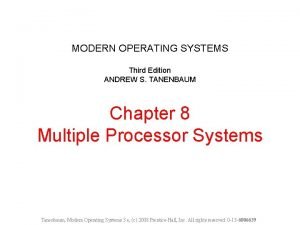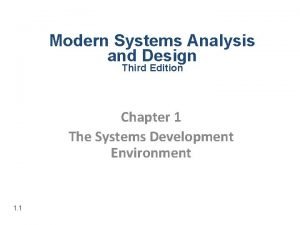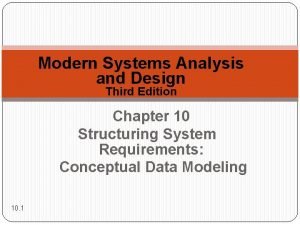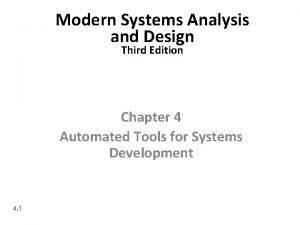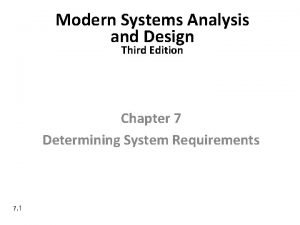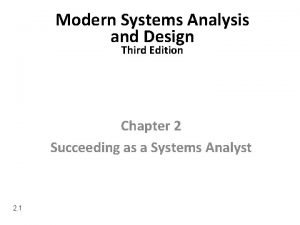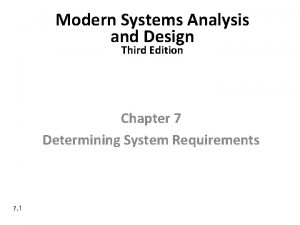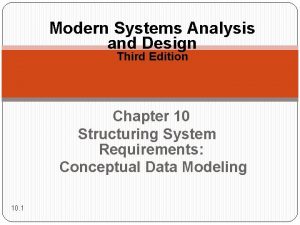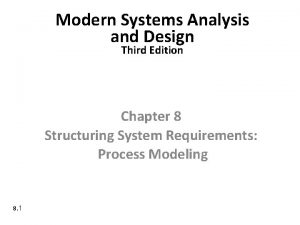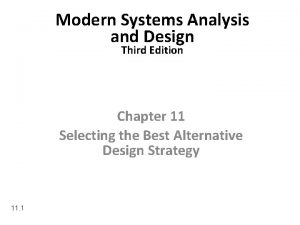Modern Systems Analysis and Design Third Edition Chapter










- Slides: 10

Modern Systems Analysis and Design Third Edition Chapter 6 Determining System Requirements 7. 1

Performing Requirements Determination � System Analysis phase has three sub phases �Requirements determination �Requirements structuring �Generating alternative design and selecting best one � Gather information on what system should do from many sources � Users � Reports � Forms � Procedures

Performing Requirements Determination � Characteristics for gathering requirements �Impertinence �Question everything �Impartiality �Find the best organizational solution �Relaxation of constraints � assuming anything is possible �Attention to detail �Reframing �View the organization in new ways 7. 3

Deliverables and Outcomes � Types of deliverables: �Information collected from users interview transcripts, questionnaire responses, notes of observation �Existing written information sample business forms and reports, procedure manuals, training manuals �Computer-based information CASE repository contents and reports of existing system �Understanding of organizational components � Business objective � Information people needs � Data handled and when, how and who moves data � Rules of data processing 7. 4

Traditional Methods for Determining Requirements � Individually interview people who knows current system � Survey people via questionnaires � Interview group of people with different needs � Observe workers at selected times to see how data is handled � Study business documents Interviewing and Listening Guidelines for Effective Interviewing � Prepare interviewee: set up appointment time and duration convenient for interviewee � Prepare checklist, agenda and questions, to know the sequence and duration of questions to ask � Listen carefully and take notes � Review notes within 2 days of interview � Be neutral and seek diverse views 7. 5

Traditional Methods for Determining Requirements �Questionnaires Vs Interviews �Interviews are very expensive and time-consuming �Questionnaires are not expensive and can gather information from many people simultaneously in a relatively short time �Interviews can have limited number of questions and limited number of people contacted �Questionnaires give less depth of understanding �Interviews provide the opportunity to judge the truthfulness of responses by the words or voice tone or the body language of the respondent �Questionnaires do not provide the opportunity to judge the accuracy of responses 7. 6

Traditional Methods for Determining Requirements � Choosing Questionnaire respondents – if more people to survey decide which set of people to send questionnaire to or which questionnaire to send to which group of people � Designing Questionnaires � Questionnaires are most useful when used for specific purpose and not for general information gathering � Questionnaires typically include closed-ended questions � Questionnaires must be extremely clear in meaning and logical in sequence How often(? ) do you backup your computer files (C: or hard disk)? a) frequently b) sometimes c) hardly at all d) never 7. 7

Traditional Methods for Determining Requirements � Interviewing Groups – interview several key people at once by several analysts, one asks questions other takes notes � Advantages � More effective use of time � Enables people to hear opinions of others and to agree or disagree � Disadvantages � Difficulty in scheduling convenient time as many people are involved 7. 8

Modern Methods for Determining Requirements A. Joint Application Design (JAD) �Similar to group interview as it brings together key users, managers and systems analysts �Purpose: collect system requirements simultaneously from key people �Particular structure of roles and agenda is followed analysts control the sequence of questions answered by users �may last from four hours to an entire week and may consist of many weeks B. Prototyping �Goal: to develop concrete specifications for ultimate system 4. 9

B. Prototyping � Quickly converts requirements to working version of system � Once the user sees requirements converted to system, will ask for modifications or will generate additional requests � Most useful when: � User requests are not clear � Few users are involved in the system � Designs are complex and require concrete form � History of communication problems between analysts and users � Tools are readily available to build prototype � Drawbacks � Tendency to avoid formal documentation � Difficult to adapt to more general user audience � Sharing data with other systems is often not considered � Systems Development Life Cycle (SDLC) checks are often bypassed 7. 10
 Modern systems analysis and design 7th edition
Modern systems analysis and design 7th edition Case tools are limited to systems analysis.
Case tools are limited to systems analysis. Modern systems analysis and design
Modern systems analysis and design A modern approach to systems analysis and design
A modern approach to systems analysis and design Distributed systems third edition
Distributed systems third edition Modern operating systems 3rd edition
Modern operating systems 3rd edition Tanenbaum structured computer organization
Tanenbaum structured computer organization Gj mount classification
Gj mount classification Mounts classification
Mounts classification Kendall and kendall
Kendall and kendall Principles of economics third edition oxford pdf
Principles of economics third edition oxford pdf




